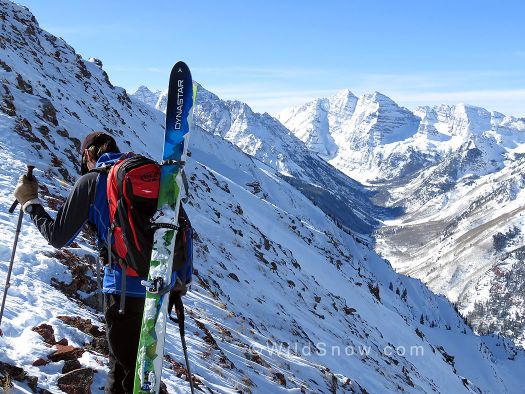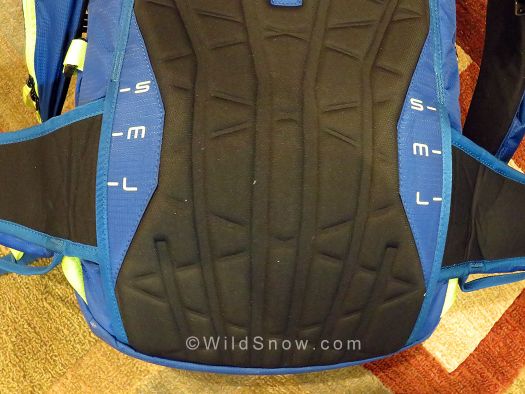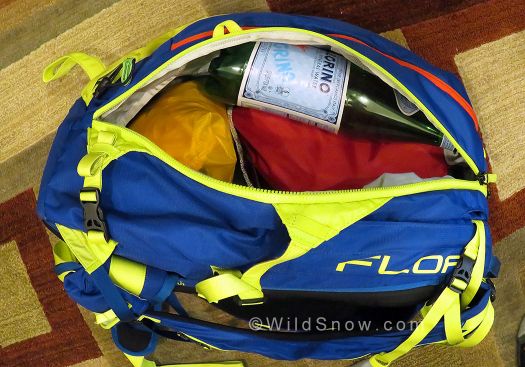Michael Arnold
AMGA/IFMGA Mountain Guide
Shop for BCA Float packs here.
(Editor’s note: I’m moving this up to the top for today, as the $549.00 Float is one of the best deals you can find in avalanche airbag rucks, and it seems folks were having trouble finding this review.)
WildSnow has reviewed various generations of the BCA Float airbag packs: in 2011, BCA Float 36 and 18, and BCA Float 30, in 2013: BCA Float 32 to name a few.
I’ve been using the redesigned BCA Float 32 and here’s my take:
At first look, I noticed the new shape — more rounded and less boxy than earlier rucksacks in the Float series. I loaded 40lbs into the pack and walked around the house, tweaking it for my fit. Then I wore the pack in the field. During the first few days of downhill skiing, I adjusted the hip belt, load limiters and sternum strap to minimize the shifting of the pack while skiing.
Fit:
The waist belt allows the torso length of the pack to be customized (the pack is sold in one size; user adjusts). The medium-to-large setting works for my 19 inch spine. I set it at medium for days when I use a climbing harness; large for days when I don’t need the pack to sit as high on my hips.
I’ve adjusted the pack for numerous guiding clients and found it fits a variety of people well, with the exception of petite females and small frame males.
When shopping for a pack, it’s a good idea to bring your gear to a shop, load the pack, and make sure it fits comfortably.
Pockets and packing:
The large volume of the main compartment makes it easy to pack a full day guide’s kit (sled, first aid, repair, avalanche essentials, food and water) and still have room to haul some extra items.
In the mountains when I’m working as a guide, I like to have compartments for my gear. The different colored zippers on the Float help me keep things organized.
In the red zipper pocket, I put my shovel and probe and there’s plenty of room for a snow saw, SP2 Avatech Probe and for the steeps, an ice axe. The ice axe is best stowed inside the pack with any avalanche airbag. When lashed to the outside of the pack, there’s the danger of puncturing a deployed airbag which is not good for your chances of survival, and no one likes getting axed in the tram either. Wherever you stow your sharps, consider some sort of storage protection. In a violent avalanche, an ice axe inside your pack is more than likely to end up puncturing its way out, perhaps in the direction of the airbag balloon. Check out this axe guard., or make your own with duct tape and plastic.
I pack all my kit top down via the clam shell main compartment. Then my other essentials (first aid, repair food and water) are easily accessed with the third zipper via the suitcase style pack. This is purely stylistic, but I have seen great efficiency with this system.
The goggle pocket is not in the most ideal location and when loaded, it impedes the packability of the main compartment.
There is a small 2 liter pocket inside for stuff like wallet and phone.
I have noticed the external zippers hold out the elements better than the old style zips. I like the 2 pockets on the hip belt.
This pack allows you to carry either skis or snowboard. Remember with any airbag you want to AVOID “A-Framing” your skis when traveling on foot in avalanche terrain. I noticed more durability in the breakable zipper of the airbag system when carrying skis are on your back. Before, we had seen the airbag zipper break apart when in ski carry mode.
The Float packs have some of the better helmet carrying options. When you carry skis diagonally, you can rotate the helmet basket and have the helmet on top of the pack. Without ski carry, a helmet fits on the backside of the pack. This has a sleek mesh “basket” that you can stow away when utilizing the helmet. The helmet carry basket is a permanently fixed component on the pack and can be stowed away when wearing the helmet. All that said, if you’re a helmet user consider simply wearing it all the time and eliminating the extra time and fiddling of stowing it on your pack.
— The airbag provides trauma protection to the head without decreasing your peripheral vision
— You can switch the trigger to either side of the pack. (Purposed to snowmobilers who like locating the trigger so it works ergonomically while they’ve got one hand on the sled throttle, but could be useful for checked baggage packing when you’re trying to sardine a bunch of items together.)
— After the airbag is deployed, I found the re-packing easy. There is a diagram on there packs showing the proper way to fold the airbag once it is deployed.
Float 32 system and travel
BCA has 200+ refill centers worldwide. The question is, where’s your next trip? When traveling, you have to carry an empty canister with the top removed. Another option is to purchase/own a full canister and ship to destination, but again, that can be tricky.
It is possible to refill the Float 32 by hand, but here at WildSnow we’re not sure doing so is advisable due to the uncertainty of how much moisture is introduced into the canister, possibly leading to ice clogging or corrosion. Here’s how.
Note: whatever kind of refill is planned, bring a refill “kit” with O-rings etc. In real life, WildSnow bloggers have had several trips when they’ve gone to the trouble of getting the cylinder filled at destination only to have it not hold air due to problems with O-rings and such.
Synopsis
Pros
— Durable
— Panel access
— Adjustable height hip belt for torso length
— Internal ice axe compartment
— Suitcase style zipper (3rd zipper on main compartment)
— Hydration and BCA Link radio compatibility via shoulder strap sleeves
— Well designed diagonal ski carry, and vertical snowboard carry
Cons
— On the heavier side (added weight from all the partitions, adjustability and complex shoulder straps, may we suggest a “Euro” edition that’s stripped down a bit?)
— Diagonal ski carry only goes one way
— Inside goggle pocket obstructs the packability in main compartment
— Air travel with the cylinder can be tricky
Specs:
Price — ~ $550 USD
Volume — 1953 cu in 32L was adequate
Deployment system — compressed air
Cylinder available to purchase separately — $175 USD
Adjustable waist belt — S-M-L
Pockets — 1 fleece-lined goggle, 2 hip, 1 internal mesh
Weight with cylinder — 7.7 pounds (3272 grams), compare to 30 liter competitor at 5.4 pounds (2446 grams).
My stats:
Height — 6ft
Waist — 30-32in
Spine — 19in
Weight — 170 lbs
(WildSnow guest blogger Mike Arnold is an IFMGA mountain guide who is co-founder of Vetta Mountain Guides. When he’s not sleeping in his Sprinter van or some hut above Chamonix, he lives in the Roaring Fork Valley of Colorado.)
Shop for BCA Float packs here.
Also see Wildsnow search results for Float, we have a lot of content due to our years of covering BCA.
Beyond our regular guest bloggers who have their own profiles, some of our one-timers end up being categorized under this generic profile. Once they do a few posts, we build a category. In any case, we sure appreciate ALL the WildSnow guest bloggers!




